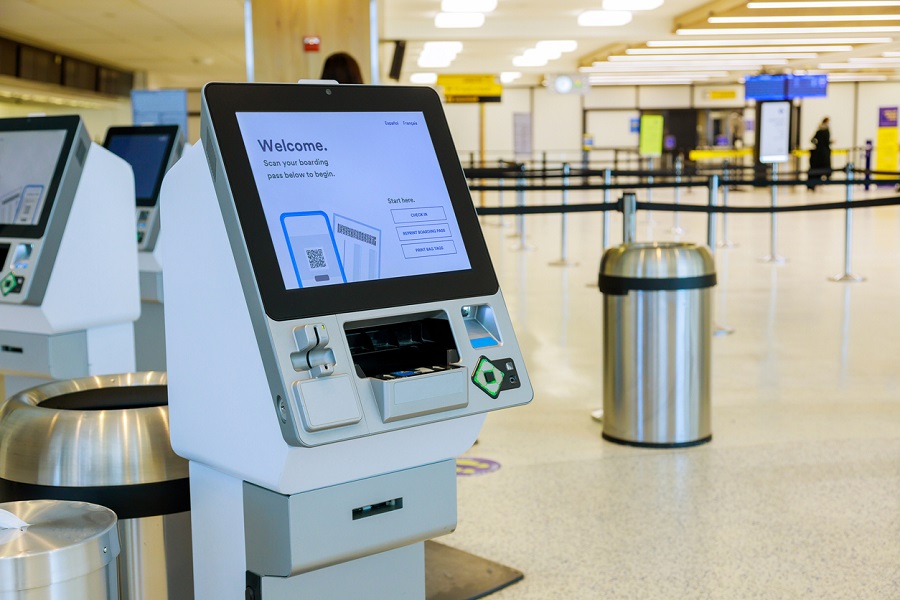A kiosk is an enclosure that is designed to hold a digital display as well as a computer and any necessary components or integrations. They are most often placed in higher-traffic areas in order to reach as many users as possible.
The word “kiosk” originally referred to the freestanding, 4-sided “miniature stores” found in malls and on city streets that offer specialty products from small businesses, or refreshments and newspapers/magazines.
Kiosk Definition & Examples
Over the years, the definition of a “kiosk” has evolved, and now also refers to self-service, digital kiosk systems, like those that allow self-payment or self-checkout. Kiosks can be used to complete any number of functions, from the simple to the complex, and may include an interactive touchscreen or a simpler static display, depending on the functionality required.

While they have been growing in popularity over the past decade, the COVID-19 pandemic has sped their adoption and made them more common even in small business environments. In fact, the kiosk industry is projected to grow at a CAGR of 7.1% from 2022 to 2030. From McDonald’s’ self-ordering kiosks, to large, interactive mall directory displays, kiosks are now found just about everywhere.
Temperature Kiosk
COVID-19 created a demand for technology that would allow organizations to operate as safely as possible. One of the most popular solutions continues to be temperature kiosks, which help companies provide consistent, proactive monitoring for symptoms like fevers in employees, guests and visitors.
Temperature-check kiosks scan the user with a touchless infrared camera using advanced thermal imagery. If the temperature sensor detects a fever, it issues an alert to both the users and assigned staff via email or text/SMS messaging.
Many organizations that operate indoors or in close quarters with large groups of people use temperature-check kiosks to screen for fevers. These include:
- Corporate business offices
- Hospitals
- Entertainment venues like stadiums, concert halls and arenas
- Museums
- Airlines
- Restaurants
Self-Service Kiosk
A self-service kiosk allows users to complete transactions or obtain information without assistance from a store associate or agent. They make many processes more efficient, including payment, check-in, and information acquisition, which reduces wait times and boosts customer satisfaction. Depending on the configuration and software, self-service kiosks can provide a wide range of services, including:

- Self-ordering in restaurants (fast food [QSRs], full-service and quick service)
- Self-payment and ticketing in entertainment venues, movie theaters and transportation hubs like bus depots and train stations
- Self-check-in hotels
- Self-baggage tagging in airports
- Wayfinding in Smart Cities
- Banking via ATMs
- Visitor and employee management in office buildings and healthcare campuses (employee sign-in/out for security)
Information Kiosk
An information kiosk displays information in a clear and easy-to-understand format that the user is able to access without assistance. The type of data available varies greatly and is dependent on the type of software and components that are chosen for the kiosk. These may include
- Local area information and weather
- Wayfinding and maps
- Employee, office or building directories
- Searchable databases for organizations like libraries and retail stores that want to offer guests the opportunity to find items without assistance from an employee
Information kiosks may be designed and manufactured with either interactive displays or non-touch displays. It’s important to keep in mind that If the kiosk is meant to offer a great deal of interactivity, most would require a touchscreen display.
Internet Kiosk
Internet kiosks are found in public places and are most often deployed as part of a “Smart City” kiosk program in urban environments. They generally provide free WiFi access, but occasionally these kiosks require a small fee to be paid before they can be used. They may also include limited internet search functionality via a web browser.
Internet kiosks can be deployed indoors or out, depending on the enclosure selected. One of the biggest advantages of an internet kiosk is that they are rugged and designed to withstand heavy use, and unlike a computer in a business center, are difficult to abuse or vandalize. Additionally, they are locked down by proprietary software that makes it unlikely that they are able to be used in malicious ways, as well as additional programs that make them hard to be “broken into” by a cyber hacker.
Wayfinding Kiosk
Digital wayfinding kiosks can improve visitor, guest, and customer experience by allowing them to find information about their surroundings and access directions unassisted. Depending on their configuration and installed software, wayfinding kiosks can include many helpful services, including:
- Turn-by-turn directions
- Interactive maps -- both 2D and 3D -- which allow users to see different building floors and navigate to and within them easily
- Lighted paths
- Kiosk-to-phone mobile hand-off via text/SMS
This type of kiosk is most commonly used in environments that span a large area, such as healthcare and educational campuses, shopping centers and airports.
Advertising Kiosks & Standing Displays
Advertising kiosks are used for marketing and branding purposes. These kiosks generally feature large display sizes in attractive enclosures, and may be freestanding or wall-mounted (some are even ceiling-mounted, especially in shopping centers). Because companies often pay for digital “space” for their ads on these kiosks based on how many “impressions” or views their ads are expected to receive, they tend to be placed in environments that receive heavy, consistent foot traffic.
Advertising displays allow businesses to communicate information to those passing by about sales, new products, loyalty programs or events, and to encourage guests to visit their stores or find them online. Content can be easily switched out and scheduled remotely. Digital advertising kiosks are also popular for displaying QR codes to engage mobile users who can scan the code and conveniently access more information about a company, brand, product or service right on their smartphones.
Benefits of Kiosks
Digital kiosks can provide organizations with a wide range of benefits, including:
- Increased efficiency
- Cost savings
- Reduced overhead
- Better quality outcomes
- Enhanced customer experience & less frustration
- Marketing opportunities
- Increased brand awareness
- Operational improvements
- Greater advertising reach
Ultimately, listening to what customers need and finding a way to provide them with what it is they are looking for is the best way to ensure their loyalty and satisfaction. While some of these needs may not be able to be automated, others, like reduced wait times, can easily be improved by self-service kiosks. While the initial cost may be substantial, the ROI -- in both revenue and guest satisfaction -- makes kiosks well worth the investment.


